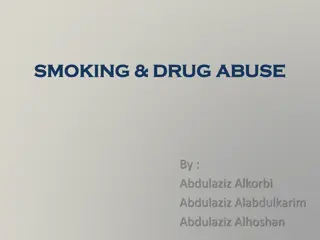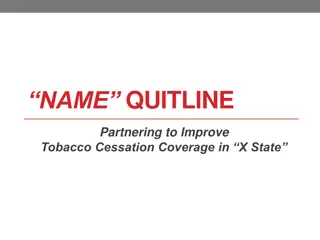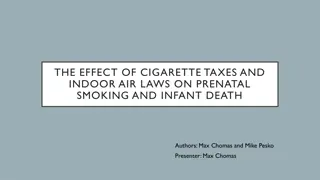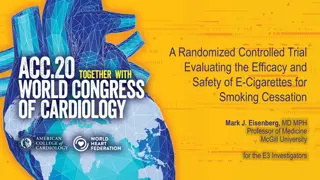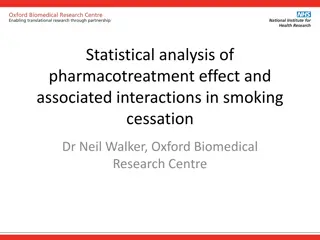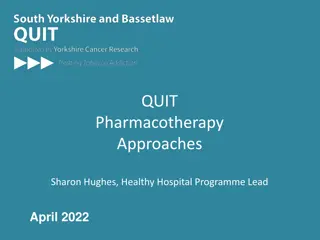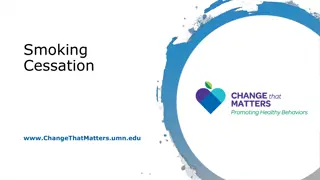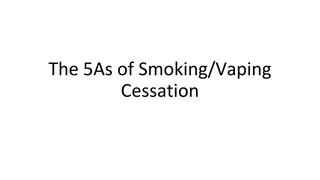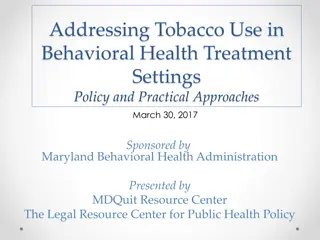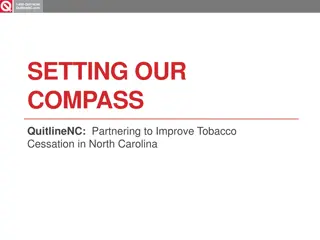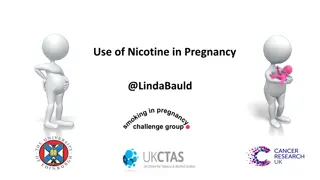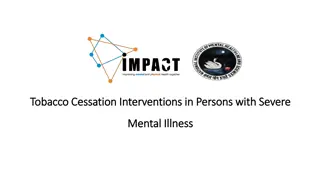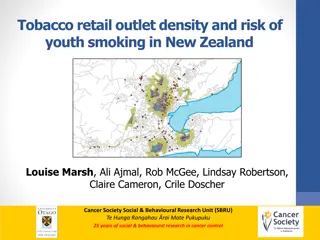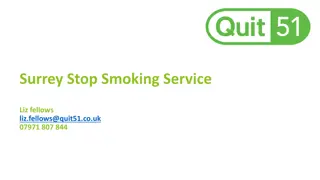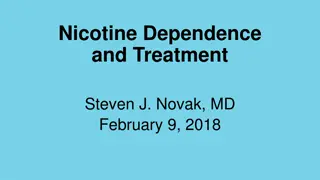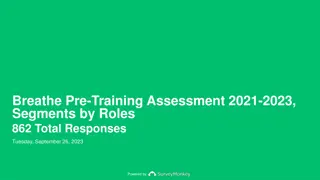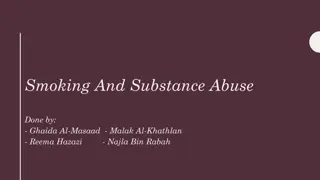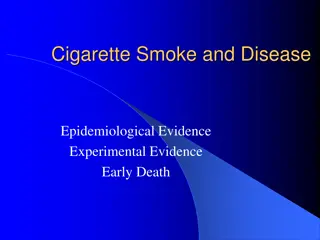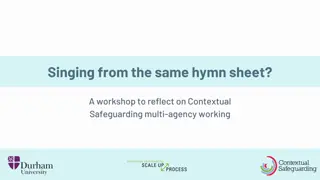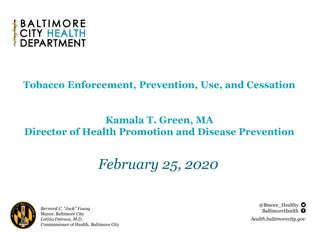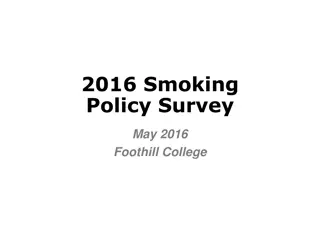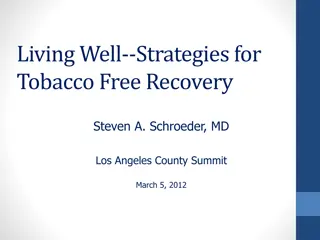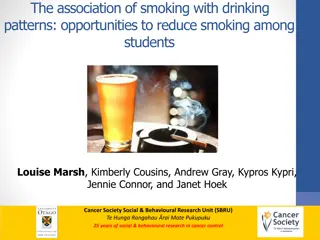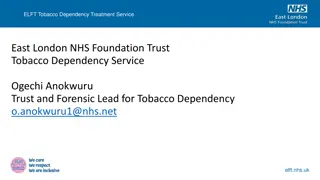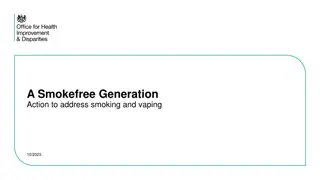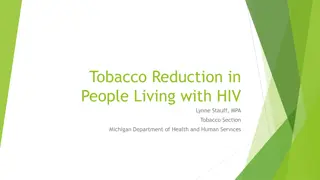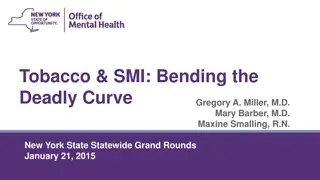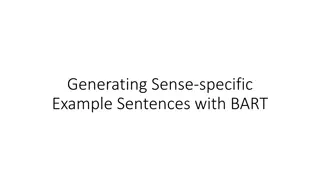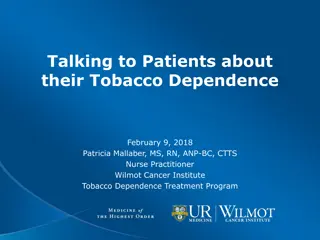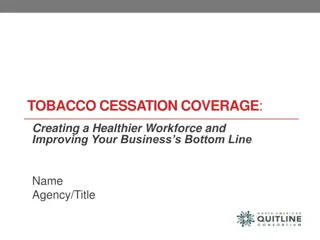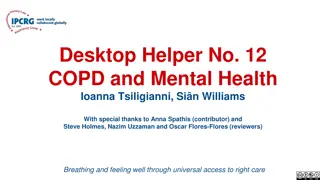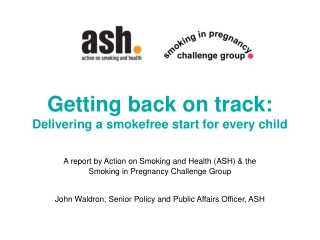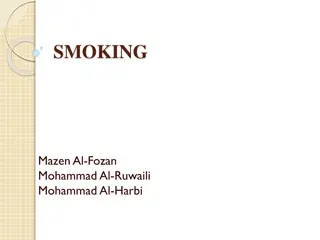Motivating Patients on Smoking Cessation: A Contextual Approach Overview
Explore behavioral interventions for smoking cessation, gain insights into effective brief interventions, and learn to apply them using real-world examples. Understand the challenges in tobacco management in primary care and discover common strategies to support patients in quitting smoking. Embrace a contextual approach to motivate and empower individuals towards a smoke-free life.
- Smoking Cessation
- Behavioral Interventions
- Tobacco Management
- Contextual Approach
- Patient Motivation
Download Presentation

Please find below an Image/Link to download the presentation.
The content on the website is provided AS IS for your information and personal use only. It may not be sold, licensed, or shared on other websites without obtaining consent from the author. Download presentation by click this link. If you encounter any issues during the download, it is possible that the publisher has removed the file from their server.
E N D
Presentation Transcript
MOTIVATING PATIENTS ON SMOKING CESSATION: A CONTEXTUAL APPROACH David Bauman, PsyD Bridget Beachy, PsyD
TODAYS AGENDA TODAY S AGENDA Who we are Who you are Tobacco management in PC Overview of tobacco Common interventions A Contextual Approach to Smoking Cessation Participants will be able to: Describe an overview of the evidence behind behavioral interventions for smoking cessation. Gain knowledge of brief behavioral interventions for smoking cessation. Apply these brief interventions to a real-world case example.
WHO WE ARE Bridget Beachy, PsyD Director of Behavioral Health for Community Health of Central Washington Roles include: Roles include: PCBH clinical, admin, and faculty for FM residency residents and psych interns David Bauman, PsyD Behavioral Health Education Director for Central Washington Family Medicine Roles include: Roles include: PCBH clinical, core faculty for FM residency, RTD of PCBH psychology internship We both live and breathe PCBH and contextual approaches (e.g., Acceptance and Commitment Therapy)
WHO YOU ARE WHO YOU ARE Poll the audience What are your professional backgrounds? Current roles? How familiar are individuals with tobacco use in PC?
CASE John is a 45 y/o male who is obese, and has type 2 diabetes and hypertension. Dr. Smith (PCP) comes into the room and sees the John sitting with who she assumes to be his wife, and can t help but notice it smells like cigarettes. Dr. Smith has a number of things she has to discuss at this visit, which include reviewing his logs to possibly make changes in his DM medications. She also will have to adjust his HTN meds. Dr. Smith hasn t had much luck with helping patients quit smoking, even after she implored them to think about what it is doing to their health. Ultimately, it s the patient s decision, she concludes, but decides to do a quick spiel anyways. She basically has it scripted, and states As we all know, your health would improve if you quit smoking. I suggest writing down every time you have a cigarette and then start reducing them, and set a quit date make sense? John agrees and says he ll try. She ups DM and HTN meds and moves on to the next patient.
OVERVIEW OF TOBACCO USE Single most preventable cause of death Around 50 million people smoke Has declined since 1965 Around 70% of smokers want to quit5-6 50% have tried in the past year Only 32% of smokers seek support Even less receive effective treatments Only 3 to 6% quit rate for unaided attempts Appropriate treatment = quit rates of 30% Providers asking and advising (<5 min.) individuals to quit: Almost doubles quit rates7 USPSTF Grade A recommendation to ask and advise to quit8 30%
USPSTF GUIDELINES8 Assessing and intervening: 5 A s Grade A Ask Ask about use Frequency of use Products used Degree of nicotine dependence How long they ve been smoking Number of cigs per day How soon after waking up History of previous quit attempts and methods Advise Advise to quit through a personalized message Assess Assess willingness to quit Assist Assist to quit Arrange Arrange follow-up and support Intervening Brief interventions (less than 10 minutes) Combination of BH and pharm better than one alone Dose response, plateau at 90 minutes (TOTAL) personalized message
MEDICATION OPTIONS 1stline medications NRT9-12 Doubles quit rates Long acting Patch Short acting Gum Lozenge Inhaler/nasal spray Best results with a long acting and a short acting Chantix Often outperforms NRT (not combination NRT)11 Bupropion13 Doubles quit rates, effective for individuals w/ and w/o MH
STAGES OF CHANGE MODEL8 Pre-contemplative Contemplative Preparation Action Maintenance What stage of change are most of interventions used for? Use Motivational Interviewing for those who are not ready8
TOOL KIT Set a Quit Date Address nicotine dependence withdrawal What it s going to feel like Advise on an NRT Self monitoring, gradual reduction vs cold turkey, preparation for quit date Identify triggers Situations Internal states (TEAMS) Activities that prompt it Drinking Being around others who smoke Interventions: Problem solving skills Behavioral and cognitive distractions Have a small, healthy snack Have a glass of water Oral strategies chew gum, chew on a straw Positive self talk and visualization Remind self of why you are quitting and benefits Stress management and relaxation Is smoking really the problem? Is smoking really the problem?
WHAT IF SMOKING IS PART OF A GREATER CONTEXT? What if we are treating a disease when it is really a symptom? High link between ACEs and smoking status17-20 As number of ACEs grows, prevalence of smoking increases Graded response Why would someone take care of their health when they do not care about themselves? But cigarettes are my friend Also, smoking may be the only stress relief they have known If they started young, think about how many pairings between smoking and stress relief there s been Before intervening, we need to understand the context of the individual Smoking might not be what we focus on; rather, we focus on improving the individual s stress-management/self-worth
ITS A MATTER OF CONTEXT Behaviors do not happen in vacuums Symptoms arise due to one s context, thus, for us to intervene appropriately we must understand the context What if instead of focusing on what shows up at 5 PM (symptoms), we focus on what show s up at 8 AM (the person s context) Focus on the soil, rather than the seed What happens when we start to do this? Disorders, pathologies, behaviors, like smoking, make sense! To us, if what is showing up doesn t make sense, we are missing the To us, if what is showing up doesn t make sense, we are missing the context context
OKAY, I AM WITH YOU, CONTEXT IS IMPORTANT But, hey, I got 15- 20 minutes with a patient what you are asking takes at least an hour Yeah, we had the same thought What if there was a way to gather the context intentionally, systematically, and sequentially We give you the Contextual Interview
#CONTEXTUALINTERVIEW LOVE, WORK, PLAY & HEALTH LOVE Living Situation Relationship Family Friends Spiritual, community life? Work/School Income/Work/school situation Play Fun/Hobbies/Relaxation Health Behaviors Exercise Diet, supplements, medications? Sleep Sex Health Risk Substance use (i.e., caffeine, cigarettes, etoh, MJ, street drugs)
FUNCTIONAL ANALYSIS: 3 TS Time When did this problem start? How often? Trigger Anything happen recently to trigger this problem? Antecedents? Trajectory What s the problem been like over time? Times it s worse? Better? Workability Strategies for addressing the problem, how it has worked in the short or long run (value consistent)? You should be able to start formulating and conceptualizing DURING the contextual interview (with practice)
#CONTEXTUALINTERVIEW Our story Every.Single.Time Depression Yep, Anxiety Yep, Treatment Adherence Yep, Smoking Yep you get the point Need to practice Also, setting up documentation to follow this Most radical shift in our clinical practice interventions are great but the CI is paramount Not a checklist, but a story builder Symptoms/behaviors do not happen in vacuums, they happen in a context Teach both our psychology interns/fellows and our residents to do this context
CASE John is a 45 y/o male who is obese, and has type 2 diabetes and hypertension. Dr. Smith (PCP) comes into the room and sees the John sitting with who she assumes to be his wife, and can t help but notice it smells like cigarettes. Dr. Smith has a number of things she has to discuss at this visit, which include reviewing his logs to possibly make changes in his DM medications. She also will have to adjust his HTN meds. Dr. Smith hasn t had much luck with helping patients quit smoking, even after she implored them to think about what it is doing to their health. Ultimately, it s the patient s decision, she concludes, but decides to do a quick spiel anyways. She basically has it scripted, and states As we all know, your health would improve if you quit smoking. I suggest writing down every time you have a cigarette and then start reducing them, and set a quit date make sense? John agrees and says he ll try. She ups DM and HTN meds and moves on to the next patient. What else do we want to know? What will you use from your tool kit?
MORE INFO http://www.2morrowinc.com/smartquit/
REFERENCES 1. Robinson PJ, Reiter JT. Behavioral Consultation and Primary Care: a Guide to Integrating Services. N ew York: Springer; 2016. Jamal A, Agaku IT, O'Connor E, et al. Current cigarette smoking among adults --United States, 2005 - 2013. MMWR Morb Mortal Wkly Rep. 2014 Nov 28;63(47):1108 12. U.S.Department of Health and Human Services. The Health Consequences of Smoking: 50 Years of Progress. A Report of the Surgeon General. Atlanta, GA: U.S. Department of Health and Human Services, Centers for Disease Control and Prevention, N ational Center for Chronic Disease Prevention and Health Promotion, Office on Smoking and Health; 2014. Cook BL, Wayne GF, Kafali EN , et al. Trends in smoking among adults with mental illness and association between mental health treatment and smoking cessation. JAMA. 2014 Jan 8;311(2):172 82 Rigotti N A. Strategies to help a smoker who is struggling to quit. JAMA 2012; 308:1573. Centers for Disease Control and Prevention (CDC). Quitting smoking among adults --United States, 2001 - 2010. MMWR Morb Mortal Wkly Rep 2011; 60:1513. Stead LF, Buitrago D, Preciado N , et al. Physician advice for smoking cessation. Cochrane Database Syst Rev 2013; 5:CD000165. Siu AL, U.S. Preventive Services Task Force. Behavioral and Pharmacotherapy Interventions for Tobacco Smoking Cessation in Adults, Including Pregnant Women: U.S. Preventive Services Task Force Recommendation Statement. Ann Intern Med 2015; 163:622. Smith SS, McCarthy DE, Japuntich SJ, et al. Comparative effectiveness of 5 smoking cessation pharmacotherapies in primary care clinics. Arch Intern Med 2009; 169:2148. Piper ME, Smith SS, Schlam TR, et al. A randomized placebo -controlled clinical trial of 5 smoking cessation pharmacotherapies. Arch Gen Psychiatry 2009; 66:1253. Cahill K, Stevens S, Perera R, Lancaster T. Pharmacological interventions for smoking cessation: an overview and network meta -analysis. Cochrane Database Syst Rev 2013; 5:CD009329. Cahill K, Stevens S, Lancaster T. Pharmacological treatments for smoking cessation. JAMA 2014; 311:193. Hurt RD, Sachs DP, Glover ED, et al. A comparison of sustained -release bupropion and placebo for smoking cessation. N Engl J Med 1997; 337:1195. Aveyard P, Lindson-Hawley N , Hastings G, de Andrade M. Should smokers be advised to cut down as well as quit? BMJ 2014; 348:g2787. Baha M, Le Faou AL. Gradual versus abrupt quitting among French treatment -seeking smokers. Prev Med 2014; 63:96. Lindson-Hawley N , Banting M, West R, et al. Gradual Versus Abrupt Smoking Cessation: A Randomized, Controlled Noninferiority Trial. Ann Intern Med 2016; 164:585. 2. 3. 4. 5. 6. 7. 8. 9. 10. 11. 12. 13. 14. 15. 16.



